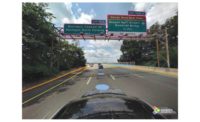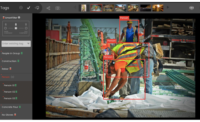Arriving at a jobsite during the COVID-19 pandemic has seen familiar sign-in sheets and fast-moving turnstiles replaced by infrared temperature checks and updated PPE briefings.
[For ENR’s latest coverage of the impacts of the COVID-19 pandemic, click here]
But many contractors are also turning to online health surveys at points of entry to speed the screening process and help reduce the likelihood of a person who is feeling ill from coming onto the site.
“I’ll always remember March 17,” says Kyle Peacock, CEO of San Francisco-based Peacock Construction. As the Bay Area went under lockdown that week, he had to adapt to keep essential construction sites operating, while complying with new city and state regulations on pre-screening workers at site for COVID-19 symptoms. “At first we did check-ins with paper just to get it done, but we knew there has to be an easier way to do this,” says Peacock.
Knowing this was going to be a nightmare across the more than 40 jobsites his company was on in the Bay Area, Peacock started talking to software developer David Ward, who saw an opportunity.
In a few short weeks, Ward and his team developed Safe Site Check In, a web-based portal that workers and visitors to jobsites can access by scanning a posted QR code with their smartphone. The secure survey asks workers how they are feeling, and can automatically notify site personnel if something comes up.
“From the contractor’s point of view it’s very simple, there’s no friction,” says Tony Totalani, head of product for Safe Site Check In. “There’s nothing the GC has to do besides set it up.”
The cloud-based system is designed specifically with mid-sized contractors like Peacock Construction in mind, and does not require any existing worker database or creation of user accounts. “We wanted something ... to get people into the jobsite without the burden of downloading apps,” says Totalani.
“We looked at a lot of other solutions but the challenge for us was they all required a subscription, or you had to download something before coming to the site,” says Peacock. “We wanted something simple, and David and his team listened to us.”
Safe Site Check In also is designed around maintaining privacy for workers and visitors, with none of their health-related answers stored in the cloud. “It’s a simple pass-fail test to enter the site,” says Totalani. “You need to provide an email and mobile phone number, but that’s just so the contractor can contact them. We only store the logs of who checked in so the contractor can review them later.”
Safe Site Check In is available with a cost of $60 per month per active jobsite, with no limit on users.
Peacock says the simple interface has allowed for workers to quickly get onto site, and they only have had one incident so far where a worker was denied entry. “We were able to get them to a testing center and get tested. In this case we were able to get them back to work,” says Peacock. “It's been good for us because all of our workers and subcontractors and clients understand how serious this is. We want to get back to work, but we need to get back to work safely.”
Adapting Existing Software for Virus-Containment
For larger GCs however, working a COVID-19 screening process into their existing workforce-management platforms is a problem that needs to be tackled now, says Jonathan Erwin, CEO and founder of Red e App. The Louisville-based software maker has been developing a workforce management app for nearly a decade aimed at industries with large, dispersed groups of employees, including construction, mining and healthcare.
“The unconnected worker does not sit at a desk,” says Erwin. “Our idea was to recreate the active directory interface for large, dispersed organizations.”
This system has been used on several massive projects with multiple layers of subcontractors and thousands of workers. Bechtel has deployed Red e App on both a major copper mine in Chile and on the sprawling Plant Vogtle nuclear project in Georgia.
Red e App is primarily used for communication, and can generate task schedules for individual workers based on their specific duties. But the COVID-19 crisis presented a challenge for Erwin and his team, who realized that there was a need to monitor the health of workers as well.
“We had clients whose employees were scared to come to work,” recalls Erwin. “In just three weeks we had a new platform that could not only accept intakes of health declarations, but users could also upload positive [COVID-19] tests.”
Erwin says the new part of Red e App, called HealthePassport, is fully live within the app. In addition to giving workers clearance on going back to work, it also has contact tracing capabilities, he adds. Pricing for the new features will be included within the Red e App subscription, but Erwin says the company is reevaluating the business model for HealthePassport.
Internally Developed Tools Tailored for Contractors’ Processes
Boston-based Shawmut Design and Construction had dozens of essential jobsites across the Northeast that had to stay open through the COVID-19 spring shutdowns. The need for faster ways of checking in workers and performing heath pre-screenings at site entrances was apparent.
"This whole initiative started with a few creative superintendents trying to meet needs of their own local projects,” recalls Dave Benson, the contractor's CIO.
“The technology to do this was built in bits and pieces, but as word go around and demand grew, the superintendents called me and said can we do something more consistently scalable,” says Benson. After checking with a few vendors, he decided that Shawmut could build something in-house to suit their needs. In less than two weeks his development team produced Shawmut Vitals, a web-based portal that workers and visitors to construction sites could access by scanning a posted QR code. After answering a few health-related questions, a worker is given a yes or no on whether they can enter the site.
“We talked to a few vendors, but while we have great respect for what they’ve done, we wanted to leverage our existing technology,” says Benson. “Our construction ERP system already knows a lot of information about our projects, and it knows all the subcontractors tied into them. With [Shawmut Vitals’ integration], we didn’t have to start over and ask everyone who they work for.”
Shawmut Vitals only stores site visitor logs for 14 days for contact-tracing purposes, and the notification to the superintendent about a person denied entry goes through a secure, cloud-based system to protect their privacy.
Benson says Shawmut Vitals has been well received within the company, especially on jobsites deemed essential that kept working through the shutdown.
“Developing this was to help protect the health and safety of our frontline workers—the way we looked at our supers and trades, they’re no different from medical workers or grocery workers,” he says. “To do their jobs these people unfortunately have to be on site, taking a risk on our behalf. My dev team felt [Shawmut Vitals] was something we owe them, to help them do their jobs safely.”






Post a comment to this article
Report Abusive Comment